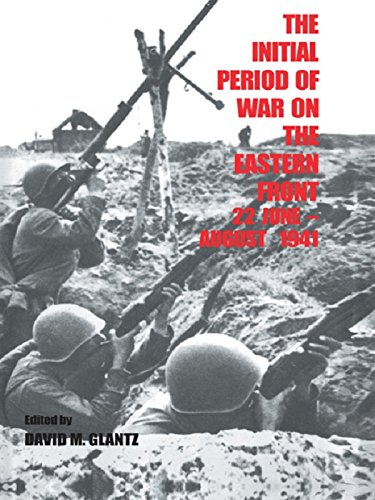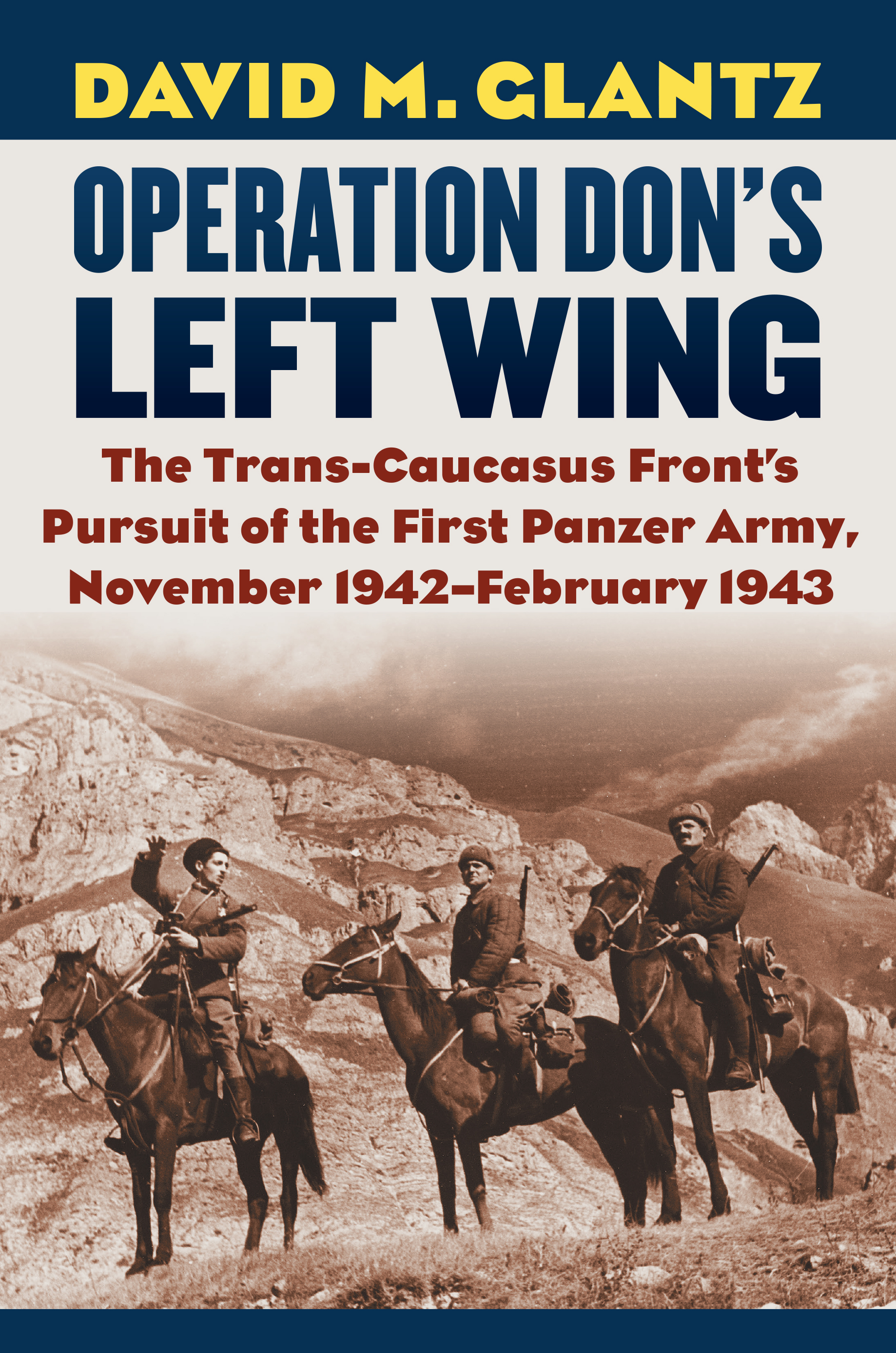
David M. Glantz is an American military historian and the editor of The Journal of Slavic Military Studies. Glantz received degrees in history from the Virginia Military Institute and the University of North Carolina at Chapel Hill, and is a graduate of the U.S. Army Command and General Staff College, Defense Language Institute, Institute for Russian and Eastern European Studies, and U.S. Army War College. He entered active service with the United States Army in 1963. He began his military career in 1963 as a field artillery officer from 1965 to 1969, and served in various assignments in the United States, and in Vietnam during the Vietnam War with the II Field Force Fire Support Coordination Element (FSCE) at the Plantation in Long Binh. After teaching history at the United States Military Academy from 1969 through 1973, he completed the army’s Soviet foreign area specialist program and became chief of Estimates in US Army Europe’s Office of the Deputy Chief of Staff for Intelligence (USAREUR ODCSI) from 1977 to 1979. Upon his return to the United States in 1979, he became chief of research at the Army’s newly-formed Combat Studies Institute (CSI) at Fort Leavenworth, Kansas, from 1979 to 1983 and then Director of Soviet Army Operations at the Center for Land Warfare, U.S. Army War College in Carlisle, Pennsylvania, from 1983 to 1986. While at the College, Col. Glantz was instrumental in conducting the annual "Art of War" symposia which produced the best analysis of the conduct of operations on the Eastern Front during the Second World War in English to date. The symposia included attendance of a number of former German participants in the operations, and resulted in publication of the seminal transcripts of proceedings. Returning to Fort Leavenworth in 1986, he helped found and later directed the U.S. Army’s Soviet (later Foreign) Military Studies Office (FMSO), where he remained until his retirement in 1993 with the rank of Colonel. In 1993, while at FMSO, he established The Journal of Slavic Military Studies, a scholarly journal for which he still serves as chief editor, that covers military affairs in the states of Central and Eastern Europe as well as the former Soviet Union. A member of the Russian Federation’s Academy of Natural Sciences, he has written or co-authored more than twenty commercially published books, over sixty self-published studies and atlases, and over one hundred articles dealing with the history of the Red (Soviet) Army, Soviet military strategy, operational art, and tactics, Soviet airborne operations, intelligence, and deception, and other topics related to World War II. In recognition of his work, he has received several awards, including the Society of Military History’s prestigious Samuel Eliot Morrison Prize for his contributions to the study of military history. Glantz is regarded by many as one of the best western military historians of the Soviet role in World War II.[1] He is perhaps most associated with the thesis that World War II Soviet military history has been prejudiced in the West by its over-reliance on German oral and printed sources, without being balanced by a similar examination of Soviet source material. A more complete version of this thesis can be found in his paper “The Failures of Historiography: Forgotten Battles of the German-Soviet War (1941-1945).” Despite his acknowledged expertise, Glantz has occasionally been criticized for his stylistic choices, such as inventing specific thoughts and feelings of historical figures without reference to documented sources. Glantz is also known as an opponent of Viktor Suvorov's thesis, which he endeavored to rebut with the book Stumbling Colossus. He lives with his wife Mary Ann Glantz in Carlisle, Pennsylvania. The Glantzes' daughter Mary E. Glantz, also a historian, has written FDR And The Soviet Union: The President's Battles Over Forei
Series
Books

Barbarossa Derailed
The Battle for Smolensk 10 July-10 September 1941: Volume 2 - The German Offensives On The Flanks And The Third Soviet … September 1941
2012

The Soviet Airborne Experience
1984

BARBAROSSA DERAILED
THE BATTLE FOR SMOLENSK 10 JULY-10 SEPTEMBER 1941 VOLUME 1
2010

Belorussia 1944
The Soviet General Staff Study
1998

Kharkov 1942
1998

The Initial Period of War on the Eastern Front, 22 June - August 1941
Proceedings Fo the Fourth Art of War Symposium, Garmisch, October, 1987 (Soviet
1992

To the Gates of Stalingrad
Soviet-German Combat Operations, April-August 1942
2009

The Great Patriotic War And The Maturation Of Soviet Operational Art 1941-1945
2014

The Battle for Leningrad, 1941-1944
2002

Operation Don's Left Wing
The Trans-Caucasus Front's Pursuit of the First Panzer Army, November 1942-February 1943
2019

The Battle of Kursk
1999

Battle for the Ukraine
The Korsun'-Shevchenkovskii Operation
1997

Operation Barbarossa
Hitler's Invasion of Russia 1941
2001

Siege of Leningrad, 1941-1944
900 Days of Terror
2001

Battle for Belorussia
The Red Army's Forgotten Campaign of October 1943 - April 1944
2016

Colossus Reborn
The Red Army at War
2005

From the Don to the Dnepr
Soviet Offensive Operations, December 1942 - August 1943 (Soviet
1991

Companion to Colossus Reborn
Key Documents and Statistics
2005

Zhukov's Greatest Defeat
The Red Army's Epic Disaster in Operation Mars, 1942
1999

Endgame at Stalingrad
Book One: November 1942
2014

Stumbling Colossus
The Red Army on the Eve of World War
1998

Red Storm over the Balkans
The Failed Soviet Invasion of Romania, Spring 1944
2006

When Titans Clashed
How the Red Army Stopped Hitler
1995

Operation Don's Main Attack
The Soviet Southern Front's Advance on Rostov, January-February 1943
2018

August Storm
The Soviet 1945 Strategic Offensive in Manchuria
1983

Stalingrad
2017

August Storm
Soviet Tactical And Operational Combat In Manchuria, 1945
1983

Armageddon in Stalingrad
September - November 1942
2009

The Soviet Strategic Offensive in Manchuria, 1945
'August Storm'
1983

The Soviet Conduct of Tactical Maneuver
Spearhead of the Offensive (Soviet
1991

Slaughterhouse
The Encyclopedia Of The Eastern Front.
2002

Endgame at Stalingrad
Book Two: December 1942--February 1943
2014

After Stalingrad
The Red Army's Winter Offensive, 1942-1943
2008

Hitler and His Generals
Military Conferences 1942-1945
2002





